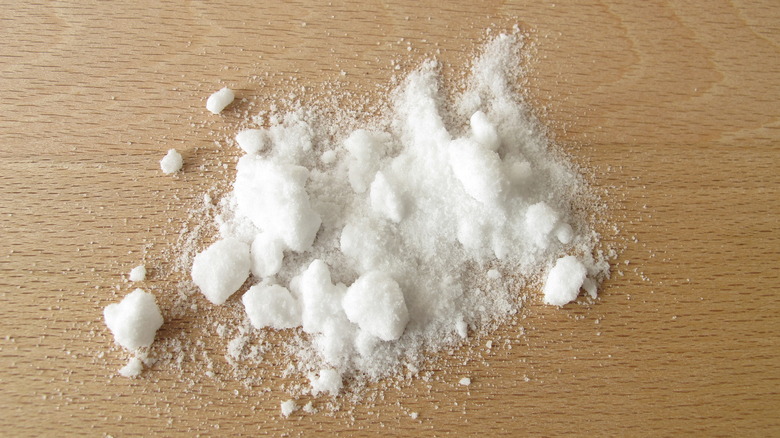Before Baking Powder, There Were Antlers
Have you ever been offered a plate of cookies and gleefully accepted, only to sink your teeth into a dense, tough hockey puck? Then, you have to force an enthusiastic "Mmmm!" to please your host, unable to speak with your jaw glued shut by cookie concrete. To ensure you don't put your guests through this ordeal, it's essential to use the proper leavening agent in your recipe. Leavening agents are the ingredients that make baked goods rise, and they do so by releasing gasses within the dough, per Britannica.
Like all methods of cooking, baking is essentially a chemistry experiment that you get to eat in the end. You might remember learning about acids and bases in school and combining an acid in the form of vinegar with a base in the form of baking soda to create a model volcano. HowStuffWorks explains that the very same bubbling reaction you remember from that childhood experiment is responsible for the air pockets in baked goods.
Now you might be wondering why we're talking so much about baking soda when the title mentions baking powder. Well, there is less of a difference between baking powder and baking soda than you might think. Baking powder is made by combining baking soda with a dry acid, so when the two are hydrated together, they output gas. It's an incredibly convenient product, but it didn't exist until the 1800s (via Cook's Illustrated). Before that, people had to get creative.
The secret of hartshorn powder
In the days before baking powder, old English recipes called for hartshorn, which begs the question, "What in the world is a hart?" Per Atlas Obscura, "hart" is an old British term for a stag or male deer. It was once tradition, after a venison dinner, for cooks to heat and pulverize the stag's antlers to form a powder they could add to their baked goods. It served the same purpose as baking powder, but the chemistry behind it was a little different.
When hartshorn powder is hydrated and heated, it releases carbon dioxide and ammonium gas, delivering the rising effect that bakers desire. The obvious issue here is that ammonium has a notoriously bad smell, as anyone who's ever cleaned a cat's litter box will know, and while most of it dissipated in the oven, Atlas Obscura notes that the aroma couldn't really be escaped.
Eventually, hartshorn was replaced with a synthetic substitute called ammonium bicarbonate, also known as ammonium carbonate, per Cook's Illustrated. This was also used as the base of many smelling salts, according to the Los Angeles Times, indicating the aroma was still an issue. Baking powder inevitably took over the baking world, surely aided by its non-unrinesque smell, but you can still buy ammonium bicarbonate. According to Cook's Illustrated, it produces a lighter and crispier end product than baking powder, but it's only useful for thin items like cookies or crackers. Anything bigger, the ammonium won't fully dissipate.

